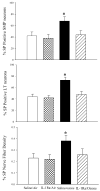Interleukin (IL)-1 regulates ozone-enhanced tracheal smooth muscle responsiveness by increasing substance P (SP) production in intrinsic airway neurons of ferret
- PMID: 18718561
- PMCID: PMC2630406
- DOI: 10.1016/j.resp.2008.07.019
Interleukin (IL)-1 regulates ozone-enhanced tracheal smooth muscle responsiveness by increasing substance P (SP) production in intrinsic airway neurons of ferret
Abstract
Exposure to ozone induces airway hyperresponsiveness (AHR) mediated partly by substance P (SP) released from nerve terminals of intrinsic airway neurons. Our recent studies showed that interleukin (IL)-1, an important multifunctional proinflammatory cytokine, increases synthesis and release of SP from intrinsic airway neurons. The purpose of this study is to investigate the possible involvement of endogenous IL-1 in modulating neural responses associated with ozone-enhanced airway responsiveness. Ferrets were exposed to 2ppm ozone or filtered air for 3h. IL-1 in the bronchoalveolar lavage (BAL) fluid was significantly increased in ozone-exposed animals and responses of tracheal smooth muscle to methacholine (MCh) and electrical field stimulation (EFS) were elevated significantly. Both the SP nerve fiber density in tracheal smooth muscle and the number of SP-containing neurons in airway ganglia were significantly increased following ozone exposure. Pretreatment with IL-1 receptor antagonist (IL-1 Ra) significantly diminished ozone-enhanced airway responses to EFS as well as ozone-increased SP in the airway. To selectively investigate intrinsic airway neurons, segments of ferret trachea were maintained in culture conditions for 24h to eliminate extrinsic contributions from sensory nerves. The segments were then exposed to 2ppm ozone in vitro for 3h. The changes of ozone-induced airway responses to MCh and EFS, and the SP levels in airway neurons paralleled those observed with in vivo ozone exposure. The ozone-enhanced airway responses and neuronal SP levels were inhibited by pretreatment with IL-1 Ra. These findings show that IL-1 is released during ozone exposure enhances airway responsiveness by modulating SP expression in airway neurons.
Figures








References
-
- Arsalane K, Gosset P, Vanhee D, Voisin C, Hamid Q, Tonnel AB, Wallaert B. Ozone stimulates synthesis of inflammatory cytokines by alveolar macrophages in vitro. Am J Respir Cell Mol Biol. 1995;13:60–68. - PubMed
-
- Baker DG, McDonald DM, Basbaum CB, Mitchell RA. The architecture of nerves and ganglia of the ferret trachea as revealed by acetylcholinesterase histochemistry. J Comp Neurol. 1986;246:513–526. - PubMed
-
- Barchasz E, Naline E, Molimard M, Moreau J, Georges O, Emonds-Alt X, Advenier C. Interleukin-1beta-induced hyperresponsiveness to [Sar9,Met(O2)11]substance P in isolated human bronchi. Eur J Pharmacol. 1999;379:87–95. - PubMed
-
- Barnes PJ, Baraniuk JN, Belvisi MG. Neuropeptides in the respiratory tract. Am Rev Respir Dis. 1991;144:1391–1399. - PubMed
-
- Becker S, Clapp WA, Quay J, Frees KL, Koren HS, Schwartz DA. Compartmentalization of the inflammatory response to inhaled grain dust. Am J Respir Crit Care Med. 1999;160:1309–1318. - PubMed
Publication types
MeSH terms
Substances
Grants and funding
LinkOut - more resources
Full Text Sources

